
BIDDINGTON'S--Gallery and Shopping
BIDDINGTON'S Home & Search

The Bentley Parks at The Doll Room for a Chat on the Care & Cleaning of Doll Hair
Dear Mrs. Biddington,
I have recently unearthed my long, lost childhood dollies. Considering how hard I played with them, them seem to be in remarkably good condition--except for their hair. I don't know what I did to them. Can you advise me on how to wash or set my dolls' hair so that they are presentable?
Hopefully yours,
Sally Spenser
My dear Sally,
My brother-in-law Freddy is acquainted with a woman who knows simply everything about doll care. Below you will find a record of one of their conversations. It should answer all your doll hair care questions.
Yours,

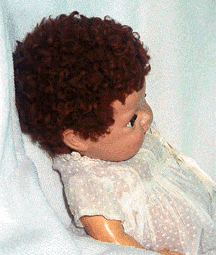
Tiny Tears with Caracul Hair Early 1950's
Correspondent's Note: Your correspondent is in Northwestern New Jersey visiting Evelyn
Kemmlein, the proprietor of the Doll Room at 735 Route 94 in Frelinghuysen Township. Her shop is filled with dolls dating from the 1920's through the1960's, a few are rare and all are highly collectible.
Evelyn performs numerous services for doll
owners/collectors. She identifies dolls . " This is a ---- ". She will also offer her opinion with regard to the approximate value of the doll. There does not seem to be a charge for this service. She is a skilled repairer and restorer of neglected dolls. Visit her shop in this pretty corner of New Jersey or call her at 908-362-5588.
Evelyn has agreed to share her
knowledge of doll hair care with the extended Biddington family.
Your Correspondent: Before we
get started, Evelyn, please tell us about the different kinds of hair we will encounter.
Evelyn Kemmlein: OK. The types are: (1) synthetic--the
typical hair of modern (since the 1950's) collectible dolls, (2) human hair, (3) mohair--from Angora goats. (Mohair and human hair are treated
identically.) Then there are:(4) caracul--short curly fur, (5) wool, (6)yarn, and finally (7) painted.
Painted is not hair at all but an embossed patternon the doll's head to suggest hair.
YC: That's quite a plateful. Let's start with synthetic hair.
EK: Synthetic hair is attached to a doll's head in one of two
ways: (1) via a wig base--a mesh or cloth netting into which the hair is sewn, or (2) the hair is rooted into the doll's head and glued from the inside.
YC: Tell us how to take care of a synthetic hair wig.
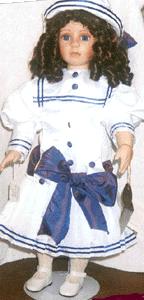
Kingstate Porcelain with Synthetic Wig
EK: Gently remove the wig base from the doll's head. Wet the
wig in cool water and spray it with either Fantastic or Windex. (Do not use shampoo which would cause serious over-fluffing.) Work the Fantastic or Windex
through the hair with your fingers, then rinse thoroughly.
YC: Now that we have clean hair, what do we do next?
EK: First untangle the doll's hair. Use a hair conditioner, such
as Clairol, or a liquid fabric softener, such as Downey. Rinse again. Now comb the doll's hair with a pet hair brush. The metal tines of the pet brush better penetrate the hair mass and exert less destructive pressure on the wig
base. Never use a hair brush that has been used on human hair. The brush
will carry oils to the doll's hair that will collect dirt and grime.
YC: How do we style the doll's hair?
EK: Styling is relatively simple. Synthetic hair has a permanent curl which only requires brushing to re-establish. If the hair does not respond use a curler, but never a curling iron--the heat will burn up the hair.
YC: Tell us about hair care of dolls with rooted synthetic
hair.
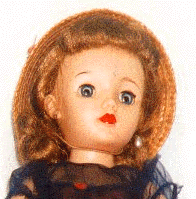
Little Miss Revlon with Rooted Saran Hair Mid-1950's
EK: While there is no wig base, hair care is very much the same: The same cleansers and rinses are applied. Observe the same cautions with one additional warning. Do not permit liquids to enter the doll's eyes. The eyes, untended, will become mildewed. If the eyes are accidentially wetted,
turn the doll face down on a cloth for hours, be patient.
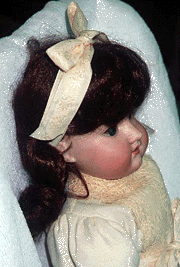
Armand Marseille Doll with Human Hair Wig
YC: Evelyn, tell us about the care of human and mohair doll
wigs.
EK: In my experience human hair is never rooted into the doll's head and is always woven into a wig base. The first job is the removal of the
wig from the doll's head. This is delicate work. Place your fingers under the
wig and work the wig away from the doll's head. If there is an unyielding
spot, spray that area with cool water. (Do not moisten if the
doll is of wood composition, the paint may loosen.)
Now, with the wig removed from the doll's head pick out tangles with a rat-tailed comb, hair pin, or ice pick. Be gentle. If the hair is being pulled out of the wig mat, switch to a soft bristle brush.
The next step is to soak the wig in Woolite and cold water.
While the wig is wet pick off any patches of glue from the wig mesh with
finger nails or tweezers. Rinse throughly. In a second bath add a few drops of vinegar to increase the lustre of the hair.
Do not scrub the wig. While taking the wig out of these baths keep your hands under the wig to retain its shape. Place the wig on a thristy towel and fan (spread) the wig into a circle. Press out as much water as possible with a second, covering, towel. Do not rub. Transfer the wig to a clean towel and put it in a warm place to dry.

Heinrich Doll with Bisque Head, Kid Leather Body and Mohair Wig
In the cleaning process the wig may either stretch or shrink. If
stretched, stitch in some tucks around the wig base until it fits the doll's head. If shrinkage has occured remove some stitches from the base. Be careful, do not cut into the hair. Human and mohair wigs are difficult to replace and they are very expensive.
YC: Evelyn, tell us a little bit about other types of
doll hair.
EK: Caracol and wool hair are usually glued to the
doll's head without a wig base. If cleaning is required use extreme care: Avoid liquids. Sprinkle talcum powder or cornstarch into the hair. With a
clean tooth brush, gently remove the powders from the doll's hair.
YC: Evelyn, let's conclude this survey with a few comments
about yarn hair.

Effanbe Little Lady--Composition Body with Yarn Hair 1940's
EK: Yarn hair is sewn or glued directly to the doll's head.
The hair may be washed with a gentle detergent such as Woolite. Never brush yarn hair.
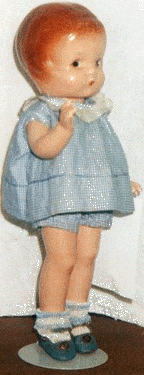
Patsy Jr. with Painted Hair
YC: Evelyn, thank you, you've been very kind to me and helpful to the Biddington family.
Family, for the record, Evelyn also sells present-day porcelain and vinyl dolls. If you need a new or older doll, visit Evelyn and this corner of New Jersey. Don't wait too long, the farms are going and ranch houses are coming.
Ask Mrs. Biddington Archives:
Ask Mrs. B--Framing and Hanging Paintings
Ask Mrs. B--Cleaning Paintings & Works on Paper
Ask Mrs. B--Framing Prints & Works on Paper
Ask Mrs. B--Lace Restoration
Ask Mrs. B--Lace Cleaning
Ask Mrs. B--Liquidating an Estate
Ask Mrs. B--Humidity & Fine Objects
Ask Mrs. B--Roseville and Removing Spray Paint
Ask Mrs. B--Care of Doll Hair
ABOUT THIS FEATURE
With fine objects, pleasure derives not only from ownership but also from acquiring the specialized knowledge involved in their conservation. Even experienced collectors may not know exactly how to care for their delicate valuables.
At BIDDINGTON'S, upmarket, online art auctions & art gallery, our in-house oracle on preservation and restoration procedures is Augusta Biddington. Mrs. Biddington is an old hand at old things. This archived feature was first published in 1998. Mrs. Biddington is no longer able to provide answers to specific questions.
COPYRIGHT: Images and information within www.biddingtons.com are © Biddington's, Inc.--except where preceded by individual copyrights of the artists.
Downloading or printing for online or print reproduction of any materials without specific written permission from Biddington's, Inc. is prohibited.
PEDIGREE & PROVENANCE--Art Words & Terms.
BIDDINGTON'S BENTLEY--Travel for the Art Connoisseur.
BIDDINGTON'S
ART VALUATION SERVICE












